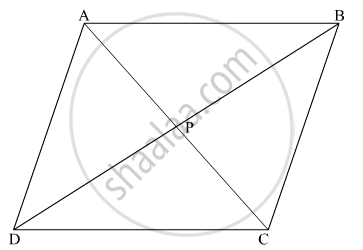Advertisements
Advertisements
प्रश्न
ABCD is a parallelogram and P is the point of intersection of its diagonals. If O is the origin of reference, show that
\[\vec{OA} + \vec{OB} + \vec{OC} + \vec{OD} = 4 \vec{OP}\]
उत्तर

Given a parallelogram ABCD and P is the point of intersection of its diagonals. We know the diagonals of a parallelogram, bisect each other. Therefore,
\[\frac{\vec{OA} + \vec{OC}}{2} = \vec{OP} \]
\[ \vec{OA} + \vec{OC} = 2 \vec{OP} . . . . . \left( 1 \right)\]
\[\text{ and }\frac{\vec{OB} + \vec{OD}}{2} = \vec{OP} \]
\[ \vec{OB} + \vec{OD} = 2 \vec{OP} . . . . . \left( 2 \right)\]
Adding (1) and (2), We get,
\[\vec{OA} + \vec{OB} + \vec{OC} + \vec{OD} = 4 \vec{OP}\]
APPEARS IN
संबंधित प्रश्न
Find the values of x and y so that the vectors `2hati + 3hatj and xhati + yhatj` are equal.
Find the scalar and vector components of the vector with initial point (2, 1) and terminal point (–5, 7).
In triangle ABC, which of the following is not true:

If `veca` and `vecb` are two collinear vectors, then which of the following are incorrect:
A girl walks 4 km towards west, then she walks 3 km in a direction 30° east of north and stops. Determine the girl’s displacement from her initial point of departure.
If `veca = vecb + vecc`, then is it true that `|veca| = |vecb| + |vecc|`? Justify your answer.
If `veca = hati +hatj + hatk, vecb = 2hati - hatj + 3hatk and vecc = hati - 2hatj + hatk` find a unit vector parallel to the vector `2veca - vecb + 3vecc`.
Let `veca = hati + 4hatj + 2hatk, vecb = 3hati - 2hatj + 7hatk ` and `vecc = 2hati - hatj + 4hatk`. Find a vector `vecd` which is perpendicular to both `veca` and `vecb`, and `vecc.vecd = 15`.
ABCDE is a pentagon, prove that
\[\overrightarrow{AB} + \overrightarrow{BC} + \overrightarrow{CD} + \overrightarrow{DE} + \overrightarrow{EA} = \overrightarrow{0}\]
ABCDE is a pentagon, prove that
\[\overrightarrow{AB} + \overrightarrow{AE} + \overrightarrow{BC} + \overrightarrow{DC} + \overrightarrow{ED} + \overrightarrow{AC} = 3\overrightarrow{AC}\]
Prove that the sum of all vectors drawn from the centre of a regular octagon to its vertices is the zero vector.
If P is a point and ABCD is a quadrilateral and \[\overrightarrow{AP} + \overrightarrow{PB} + \overrightarrow{PD} = \overrightarrow{PC}\], show that ABCD is a parallelogram.
ABCD are four points in a plane and Q is the point of intersection of the lines joining the mid-points of AB and CD; BC and AD. Show that\[\vec{PA} + \vec{PB} + \vec{PC} + \vec{PD} = 4 \vec{PQ}\], where P is any point.
Write \[\overrightarrow{PQ} + \overrightarrow{RP} + \overrightarrow{QR}\] in the simplified form.
If `veca=2hati+hatj-hatk, vecb=4hati-7hatj+hatk`, find a vector \[\vec{c}\] such that \[\vec{a} \times \vec{c} = \vec{b} \text { and }\vec{a} \cdot \vec{c} = 6\].
Find the unit vector in the direction of the sum of the vectors `2hati + 3hatj - hatk and 4hati - 3hatj + 2hatk .`
If `6hati + 10hatj + 3hatk = x(hati + 3hatj + 5hatk) + y(hati - hatj + 5hatk) + z(hati + 3hatj - 4hatk)`, then ______
`[(bar"a", bar"b" + bar"c", bar"a" + bar"b" + bar"c")]` = ______.
Find the value of λ such that the vectors `vec"a" = 2hat"i" + lambdahat"j" + hat"k"` and `vec"b" = hat"i" + 2hat"j" + 3hat"k"` are orthogonal ______.
`veca, vecb` and `vecc` are perpendicular to `vecb + vecc, vecc + veca` and `veca + vecb` respectively and if `|veca + vecb|` = 6, `|vecb + vecc|` = 8 and `|vecc + veca|` = 10, then `|veca + vecb + vecc|` is equal to
A vector whose initial and terminal point continues is known as:-
Find the value of `x` and `y`. so that the vectors `2hatj + 3hatj` and `xhati + yhati` are equal
If in ΔABC, `vec(BA) = 2veca` and `vec(BC) = 3vecb`, then `vec(AC)` is ______.
ABCD is a rhombus whose diagonals intersect at E . Then `vec(EA) + vec(EB) + vec(EC) + vec(ED)` equals to ______.
